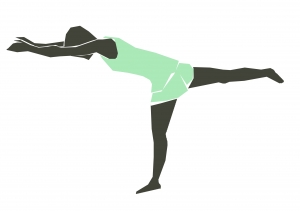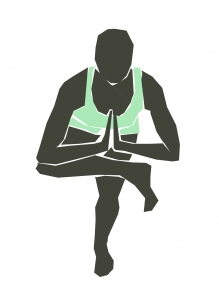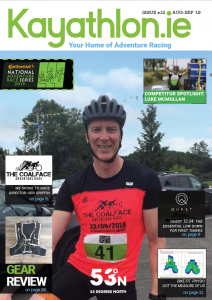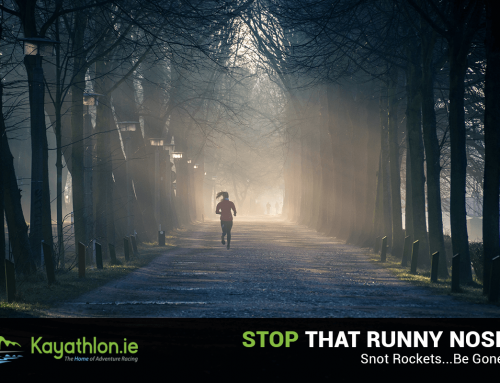In a previous issue, we examined Tree Pose and all its magical benefits-one of these being that of enhanced focus and balance, using what is referred to in yoga as, ‘drishti’ or point of focus.
This is where we fix our gaze on a stationary point, be it an object, an extended finger tip, our belly button, and, yes, this helps us engage with the physical balance, but on a deeper level it allows us clear our mind of the ‘chitta vritti’ or monkey thoughts, and allows us be truly in the moment.
According to Jim Murphy, performance coach, the amateur athlete has 3 to 4 times the amount of thoughts as the elite. Clearing the mind of clutter, of random, often negative thoughts, is one of the largest obstacles in an athlete’s path.
In order to explain how yoga can benefit the mind, I will describe a sequence which not only allows us achieve balance through core engagement, correct hip alignment, strengthening legs, stabilizing ankles, opening chest, and lengthening spine, but it also teaches us focus, because without this focus we will inevitably fall.
 A.
A.
Standing pose – Feet together, toes spread, rooted To ground. Engage legs, core, press hands together. Roll open chest drawing shoulder blades together down the spine. Chin tucked slightly to release neck.
 B.
B.
Hands to hips. Root left leg, bend and lift right leg until knee is in line with hip. Check both hips are level. Foot engaged.
 C.
C.
Hands reach to sky, hugging the arms to the ears but drawing shoulders away from ears.
 D.
D.
Upper body extends forward as right leg extends back, engaging the glute. Engage the core for a nice long spine.
E.
Return to C
 F.
F.
Cross right leg over left resting right ankle just above left knee, drawing open the hip and engaging the right glute.
 G.
G.
Hands to heart.
 H.
H.
(Added variation) Slowly sit back into a half chair pose, keeping a long spine. Engage left quad to stand and feel a lovely release into left glute.
 I.
I.
(Added variation) If close to floor rest finger tips on floor to enhance the glute stretch and hip opening.
J.
Back through G, C, A. To be done both sides, 3-5 breaths per pose.
So, what can we learn from this sequence outside of the physical?
OPTIMISM V PESSIMISM
“Whether you think you can or you think you can’t – you’re right” Henry Ford.
I notice that the yogis who tend to fall out of this sequence, although physically able, often allow their mental limitations control what their physical potential could be “My balance is woeful” “ I have no core”, “My ankles are too weak”.
The mind is a lot stronger than the body, and controls all of our
DONT BE AFRAID TO FALL
If we fall out of a pose what is the worst that can happen?
Remember one time long long ago we could not walk? But then we tried. And we fell. Again. And again. But eventually we stood. Soon after we waddled, which became a walk. And eventually we ran.
So maybe our hill climbing has seen better days, but the more mountains we climb, and the more times we fall, the stronger we become.
LISTEN TO YOUR BODY
Although the mind may be stronger, the body is our best teacher.
Notice the imbalances, where it is easier on one side over the other, where one leg extends more. Body awareness and noticing these subtleties is difficult when we are constantly grinding out the miles. It is through the slow controlled movement practices, like yoga, that we can notice these imbalances, acknowledge them and deal with them before they become an injury.
FOCUS AND BREATH
My favourite part of this pose is that you cannot but be 100% focused and in the moment, or you fall. Find a point of focus (‘drishti’), something
fixed to rest the gaze on. Engaging the core and the standing leg muscles and working with an even controlled breathe can help with this. It is the perfect pose for clearing the mind and focusing on the present. Mindfulness, body awareness and focus are often what separate those on the podium. But also, it allows us really appreciate and savour every precious moment of the adventure.
EMBRACE CHANGE
Rather than resisting the pose, for fear of falling flat on your face, embrace the new. If we resist change we will never improve in our sport. If we constantly follow the same training regime without noticeable improvement perhaps its time to change. Try a new training program, a coach, running style, go more off road, jump into the sea, whatever floats your boat
INNER FOCUS
When you lose concentration in this sequence and the mind wanders, you will fall. In fact you might not even start the sequence if you cannot shut out the background noise.
By focusing on your drishti point, engaging your core, controlling your breath and avoiding negative self-talk, the sequence becomes yours.
Focus on what you can do in that moment. And in a race, keep this inner focus, not distracted by your opponents, and you will always surpass your goals big or small!

Extract from August/September magazine.
Make sure to tune into the upcoming issue for more great yoga tips from Laura.







Leave A Comment